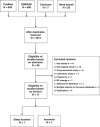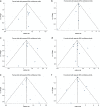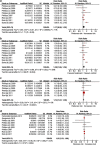The relationship of sleep duration and insomnia to risk of hypertension incidence: a meta-analysis of prospective cohort studies
- PMID: 24005775
- PMCID: PMC3819519
- DOI: 10.1038/hr.2013.70
The relationship of sleep duration and insomnia to risk of hypertension incidence: a meta-analysis of prospective cohort studies
Abstract
To assess whether habitual sleep duration or insomnia increase the incidence of hypertension. PubMed, EMBASE and Cochrane were searched without language restriction. Prospective cohort studies of adults with at least a 1-year follow-up duration were included. Habitual sleep duration or symptoms of insomnia were assessed as baseline exposure, and the outcome was incidence of hypertension. Subgroup, meta-regression and sensitivity analyses were conducted to assess heterogeneity, and Egger's test was used to assess publication bias. Eleven studies (17 cohorts) were included. Short sleep duration, sleep continuity disturbance (SCD), early-morning awakening (EMA) and combined symptoms of insomnia increased the risk of hypertension incidence (the relative risks (95% confidence intervals) were 1.21 (1.05-1.40) for short sleep duration, 1.20 (1.06-1.36) for SCD, 1.14 (1.07-1.20) for EMA and 1.05 (1.01-1.08) for combined insomnia symptoms). Less evidence exists to support conclusions about the association between long sleep duration or difficulty falling asleep (DFA) and hypertension incidence. No obvious heterogeneity or publication biases were found. Our meta-analysis demonstrates that short sleep duration and single/combined symptoms of insomnia (except DFA) are associated with an increased risk of hypertension incidence. It is important to consider sleep duration and insomnia during hypertension prevention and treatment. More laboratory studies on potential mechanisms and prospective observational studies with objective measures of sleep are needed.
Figures




Comment in
-
Short sleep duration and insomnia associated with hypertension incidence.Hypertens Res. 2013 Nov;36(11):932-3. doi: 10.1038/hr.2013.83. Epub 2013 Sep 5. Hypertens Res. 2013. PMID: 24005776 Free PMC article. No abstract available.
References
-
- Rechtschaffen A, Bergmann BM, Everson CA, Kushida CA, Gilliland MA. Sleep deprivation in the rat: X. Integration and discussion of the findings. Sleep. 1989;12:68–87. - PubMed
-
- Tasali E, Leproult R, Spiegel K. Reduced sleep duration or quality: relationships with insulin resistance and type 2 diabetes. Prog Cardiovasc Dis. 2009;51:381–391. - PubMed
-
- Riemann D, Spiegelhalder K, Feige B, Voderholzer U, Berger M, Perlis M, Nissen C. The hyperarousal model of insomnia: a review of the concept and its evidence. Sleep Med Rev. 2010;14:19–31. - PubMed
Publication types
MeSH terms
LinkOut - more resources
Full Text Sources
Other Literature Sources
Medical
Research Materials
